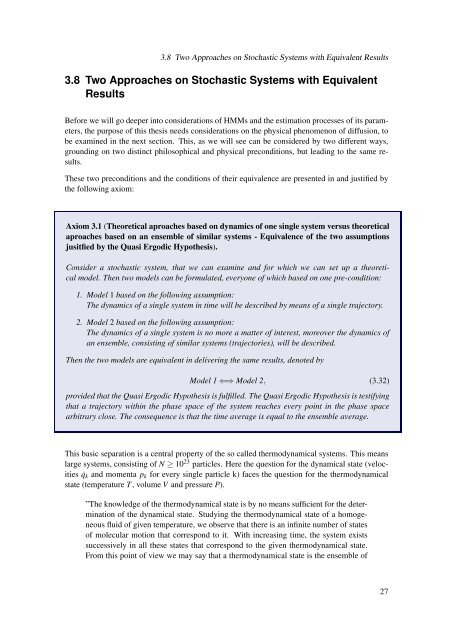Diffusion Processes with Hidden States from ... - FU Berlin, FB MI
Diffusion Processes with Hidden States from ... - FU Berlin, FB MI
Diffusion Processes with Hidden States from ... - FU Berlin, FB MI
Create successful ePaper yourself
Turn your PDF publications into a flip-book with our unique Google optimized e-Paper software.
3.8 Two Approaches on Stochastic Systems <strong>with</strong> Equivalent Results3.8 Two Approaches on Stochastic Systems <strong>with</strong> EquivalentResultsBefore we will go deeper into considerations of HMMs and the estimation processes of its parameters,the purpose of this thesis needs considerations on the physical phenomenon of diffusion, tobe examined in the next section. This, as we will see can be considered by two different ways,grounding on two distinct philosophical and physical preconditions, but leading to the same results.These two preconditions and the conditions of their equivalence are presented in and justified bythe following axiom:Axiom 3.1 (Theoretical aproaches based on dynamics of one single system versus theoreticalaproaches based on an ensemble of similar systems - Equivalence of the two assumptionsjusitfied by the Quasi Ergodic Hypothesis).Consider a stochastic system, that we can examine and for which we can set up a theoreticalmodel. Then two models can be formulated, everyone of which based on one pre-condition:1. Model 1 based on the following assumption:The dynamics of a single system in time will be described by means of a single trajectory.2. Model 2 based on the following assumption:The dynamics of a single system is no more a matter of interest, moreover the dynamics ofan ensemble, consisting of similar systems (trajectories), will be described.Then the two models are equivalent in delivering the same results, denoted byModel 1 ⇐⇒ Model 2, (3.32)provided that the Quasi Ergodic Hypothesis is fulfilled. The Quasi Ergodic Hypothesis is testifyingthat a trajectory <strong>with</strong>in the phase space of the system reaches every point in the phase spacearbitrary close. The consequence is that the time average is equal to the ensemble average.This basic separation is a central property of the so called thermodynamical systems. This meanslarge systems, consisting of N ≥ 10 23 particles. Here the question for the dynamical state (velocities˙q k and momenta p k for every single particle k) faces the question for the thermodynamicalstate (temperature T , volume V and pressure P).”The knowledge of the thermodynamical state is by no means sufficient for the determinationof the dynamical state. Studying the thermodynamical state of a homogeneousfluid of given temperature, we observe that there is an infinite number of statesof molecular motion that correspond to it. With increasing time, the system existssuccessively in all these states that correspond to the given thermodynamical state.From this point of view we may say that a thermodynamical state is the ensemble of27









